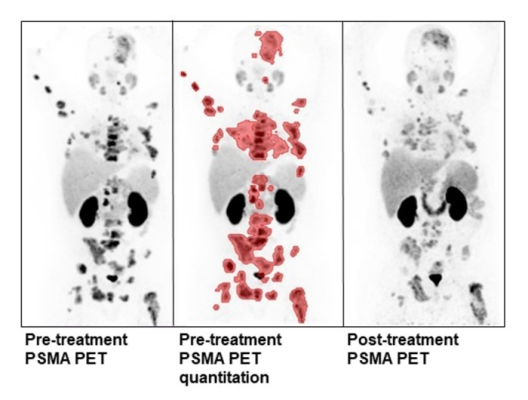
Quantitative analysis of pre-treatment PSMA PET/CT in a patient undergoing treatment with ¹⁷⁷Lutetium-PSMA-617/NOX66. Post-treatment PSMA PET/CT demonstrates reduced tumor volume and PSMA intensity. Images created by S Pathmanandavel and L Emmett, St Vincent's Hospital, Sydney, Australia.
April 11, 2022 — A novel nuclear medicine combination therapy has been proven safe and effective in men with heavily pre-treated metastatic castration-resistant prostate cancer (mCRPC). The therapy, which combines the newly FDA-approved radionuclide therapy 177Lu-PSMA-617 with a radiosensitizer known as idronoxil (NOX66), reduced prostate specific antigen (PSA) levels by more than 50 percent in a significant number of patients, resulting in a median overall survival of 19.7 months. This research was published in the April issue of The Journal of Nuclear Medicine.
mCRPC is a lethal disease, with a five-year survival rate of only 30 percent. Treatment options are limited, and treatment resistance occurs frequently. Combination therapies, however, may overcome these resistance mechanisms and improve patient outcomes.
“NOX66 has shown potential as a radiation sensitizer in prostate cancer. Our study was developed to determine if combining NOX66 with 177Lu-PSMA-617 could improve treatment response with minimal increase in toxicity for mCRPC patients,” said Louise Emmett, MD, MBChB, FRACP, director of theranostics and nuclear medicine at St. Vincent’s Hospital in Sydney, Australia.
The study included 56 men with progressive mCRPC who were previously treated with chemotherapy and novel androgen signaling inhibitors (ASI), a type of hormonal therapy. Patients received up to six doses of 177Lu-PSMA-617 in combination with varying doses of NOX66. After a median follow-up of 21.8 months, 86 percent of patients saw a decline in PSA levels, and nearly two-thirds of them had a PSA level decline of more that 50 percent.
Researchers also analyzed clinical, blood-based, and molecular imaging markers as potential predictors of treatment response. PSMA tumor volume at baseline measured by molecular imaging was the strongest predictor of treatment response and overall survival; the study found that men with higher tumor volumes responded poorly to treatment. Duration of treatment with ASI (more than 12 months) was associated with improved overall survival.
Emmett noted that these results point to two issues: “First, we need to ensure that men receive treatment earlier, before they have high-volume disease, and second, we need to explore why men with high-volume disease respond to treatment poorly,” she said. “Do we need to personalize radionuclide dose based on disease volume to get better treatment responses in men with high-volume disease? Further research is needed. It is clear, however, that trials like this help us explore how to safely prolong treatment responses and help men live longer, better lives.”
For more information: https://jnm.snmjournals.org/
Related prostate cancer content:
SNMMI Applauds FDA Approval of New Metastatic Prostate Cancer Treatment
PSMA PET Validates EAU Classification System to Determine Risk of Prostate Cancer Recurrence
VIDEO: MRI-Linac and PSMA PET Imaging Technologies Aids Therapy at GenesisCare
FDA Approves First Commercially Available PSMA PET Imaging Agent for Prostate Cancer
PSMA-Targeted Radiotracer Pinpoints Metastatic Prostate Cancer Across Anatomic Regions
Metastatic Prostate Cancer on the Rise Since Decrease in Cancer Screenings
Rational Surgical Solutions’ mCRPC Master Now Offered as Free Download


 December 04, 2025
December 04, 2025 









